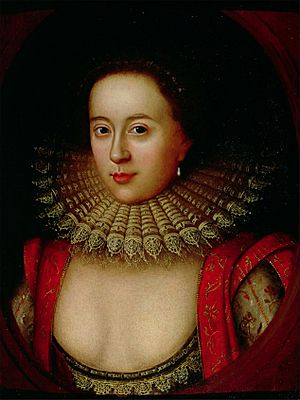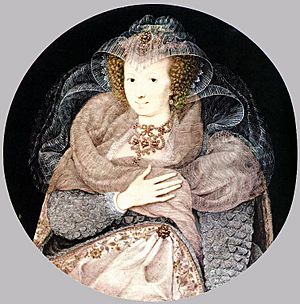Frances Carr, Countess of Somerset facts for kids
Quick facts for kids Frances Carr |
|
|---|---|
| Countess of Somerset | |

Frances Howard, Countess of Somerset
|
|
| Born | 31 May 1590 |
| Died | 23 August 1632 (aged 42) Chiswick, London, England |
| Buried | 27 August 1632 St Mary the Virgin, Saffron Walden, Essex, England |
| Noble family | Howard family |
| Spouse(s) | Robert Devereux, 3rd Earl of Essex Robert Carr, 1st Earl of Somerset |
| Issue | |
| Father | Thomas Howard, 1st Earl of Suffolk |
| Mother | Catherine Knyvett |

Frances Carr, Countess of Somerset (31 May 1590 – 23 August 1632), born Frances Howard, was an English noblewoman who was the central figure in a famous scandal and murder during the reign of King James I. She was found guilty but spared execution, and was eventually pardoned by the King and released from the Tower of London in early 1622.
Family
She was born Frances Howard, the daughter of Lord Thomas Howard (later 1st Earl of Suffolk), and his wife, the former Catherine Knyvet. Frances' father was the second son of Thomas Howard, 4th Duke of Norfolk, a wealthy and powerful nobleman during the late 16th and early 17th centuries, and Margaret Audley, Duchess of Norfolk. Frances' maternal grandparents were Sir Henry Knyvet, of Charlton, Wiltshire, and Elizabeth Stumpe.
Failed marriage
Lady Frances Howard was married at the age of 14 to the 13-year-old Robert Devereux, 3rd Earl of Essex, the grandson of Francis Walsingham. The marriage was primarily a political union and due to both their young ages, they did not live together.
Her husband was then sent on Grand Tour from 1607 to 1609. When he returned she made every effort to avoid him. He was at the time seriously ill with smallpox. She was at court and on 5 June 1610 danced as the "Nymph of Lee" representing the Essex River Lea in the masque Tethys' Festival.
She had also fallen in love with Robert Carr, 1st Earl of Somerset. When she finally took the step of annulment, unable to legally represent herself, her father and her uncle, Henry Howard, Earl of Northampton, represented her and drew up the libel. The annulment languished and possibly would not have been granted if it were not for the king's intervention (Somerset was the favourite of King James). James I of England granted the annulment on 25 September 1613. Frances married Somerset on 26 December 1613.
A murderous plot
Sir Thomas Overbury, a close friend and advisor of Somerset, had tried to advise Somerset not to marry Frances Howard, but the Howard family and their allies were powerful. The Howard faction persuaded the king to offer Overbury the post of Ambassador to Russia, knowing he would refuse in order to stay in England by Somerset's side. When he did so, the king viewed this as an insult and imprisoned Overbury in the Tower of London, where he died. The annulment of Frances and Essex's marriage went through eleven days after Overbury's death, in September 1613.
18 months later, in the summer of 1615, a Yorkshire apothecary's assistant confessed on his deathbed that he had been paid £20 by the Countess of Essex to supply her with poisons for murdering Overbury. James I's Secretary of State, Sir Ralph Winwood, brought the accusations to the King's attention in September, and James in turn urged his Privy Council to investigate the matter. The subsequent investigation and trial revealed that Frances had been surreptitiously poisoning Overbury for some time before his death, by smuggling jellies and tarts into his chamber tainted with white arsenic and other toxic compounds.
The Lieutenant of the Tower, Gervase Helwys, admitted that he had received a confession from Overbury's keeper, Richard Weston, that he had been bribed by the Countess of Essex to administer the poison. Helwys intercepted the tainted sweets at one point and from then on took the precaution of having Overbury's food prepared in his private kitchen, taking care to intercept any other food before it could reach Overbury.
However, for fear of the Countess of Essex's political influence, and because his own patron was Frances' great uncle Henry Howard, 1st Earl of Northampton, he took no action against her. Frances eventually succeeded in poisoning Overbury with a smuggled enema laced with mercury chloride.
Frances and her husband were arrested for the murder in mid-October 1615. The trial revealed that Frances had supplied the poisoned enema to Richard Weston through an intermediary, Frances' waiting-woman and companion Mrs. Anne Turner.
Helwys was tried as an accessory, and his patron at Court, Sir Thomas Monson, arrested and imprisoned for involvement. Between mid-October and December 1615, Helwys, Turner, Weston, and the apothecary James Franklin, were all found guilty as accessories to murder and hanged. Monson twice had his trial delayed, in November and December 1615, before prosecution was ultimately dropped.
Frances Somerset admitted her complicity in the crime; however, her husband maintained his innocence. In 1616 Frances was found guilty of murder, while her husband was found guilty of being an accessory after the deed when it was proven that he burned incriminating documents and made bribes to cover up his wife's involvement. The couple were sentenced to death initially but later confined to the Tower for life on the orders of James I. They received a pardon from the King in January 1622 and were subsequently released from prison. She died 10 years later at the age of 42.
Lord and Lady Somerset had one daughter, Anne, born while Frances was under house arrest[4] before she was taken to prison in the Tower of London. She was looked after by Frances's sister Lady Knollys. Anne married William Russell, 1st Duke of Bedford. Through her Lady Somerset was the ten-times-great grandmother of the actress Celia Imrie.
Frances was buried at the family seat in Audley End, Essex.

